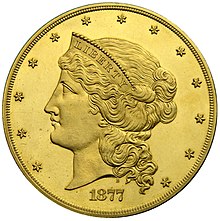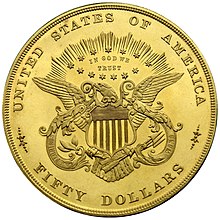
A nickel, sometimes mistakenly spelled "nickle", is a five-cent coin struck by the United States Mint. Composed of cupronickel, the piece has been issued since 1866. Its diameter is 0.835 inches (21.21 mm) and its thickness is 0.077 inches (1.95 mm).
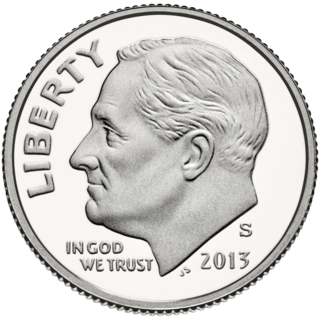
The dime, in United States usage, is a ten-cent coin, one tenth of a United States dollar, labeled formally as "one dime". The denomination was first authorized by the Coinage Act of 1792.
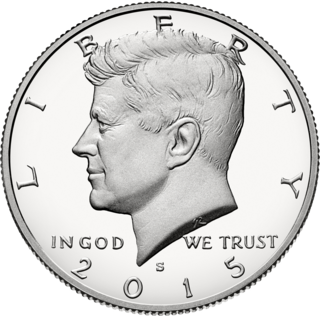
The half dollar, sometimes referred to as the half for short or 50-cent piece, is a United States coin worth 50 cents, or one half of a dollar. In both size and weight, it is the largest United States circulating coin currently produced, being 1.205 inches in diameter and 0.085 in (2.16 mm) in thickness, and is twice the weight of the quarter. The coin's design has undergone a number of changes throughout its history. Since 1964, the half dollar depicts the profile of President John F. Kennedy on the obverse and the seal of the president of the United States on the reverse.

A double eagle is a gold coin of the United States with a denomination of $20. The coins are 34 mm × 2 mm and are made from a 90% gold and 10% copper alloy and have a total weight of 1.0750 troy ounces.

The Liberty Head nickel, sometimes referred to as the V nickel because of its reverse design, is an American five-cent piece. It was struck for circulation from 1883 until 1912, with at least five pieces being surreptitiously struck dated 1913. The obverse features a left-facing image of the goddess of Liberty.
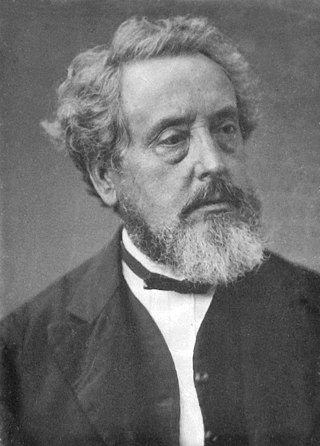
William Barber was Chief Engraver of the United States Mint from 1869 until his death in 1879. He succeeded James B. Longacre in the position.

The American twenty-cent piece is a coin struck from 1875 to 1878, but only for collectors in the final two years. Proposed by Nevada Senator John P. Jones, it proved a failure due to confusion with the quarter, to which it was close in both size and value.

A pattern coin is a coin which has not been approved for release, but produced to evaluate a proposed coin design. They are often off-metal strike, to proof standard or piedforts. Many coin collectors collect and study pattern coins because of their historical importance. Many of the world's most valuable coins are pattern coins; nearly 25 of the pieces listed in 100 Greatest US Coins are pattern coins.

The Indian Head cent, also known as an Indian Head penny, was a one-cent coin ($0.01) produced by the United States Bureau of the Mint from 1859 to 1909. It was designed by James Barton Longacre, the Chief Engraver at the Philadelphia Mint.

The Flying Eagle cent is a one-cent piece struck by the Mint of the United States as a pattern coin in 1856 and for circulation in 1857 and 1858. The coin was designed by Mint Chief Engraver James B. Longacre, with the eagle in flight based on the work of Longacre's predecessor, Christian Gobrecht.

The Shield nickel was the first United States five-cent piece to be made out of copper-nickel, the same alloy of which American nickels are struck today. Designed by James B. Longacre, the coin was issued from 1866 until 1883, when it was replaced by the Liberty Head nickel. The coin takes its name from the motif on its obverse, and was the first five-cent coin referred to as a "nickel"—silver pieces of that denomination had been known as half dimes.

The Buffalo nickel or Indian Head nickel is a copper–nickel five-cent piece that was struck by the United States Mint from 1913 to 1938. It was designed by sculptor James Earle Fraser.

The United States trade dollar was a dollar coin minted by the United States Mint to compete with other large silver trade coins that were already popular in East Asia. The idea first came about in the 1860s, when the price of silver began to decline due to increased mining in the western United States. A bill providing in part for the issuance of the trade dollar was eventually put before Congress, where it was approved, and signed into law as the Coinage Act of 1873. The act made trade dollars legal tender up to five dollars. A number of designs were considered for the trade dollar, and an obverse and reverse created by William Barber were selected.

The three-dollar piece was a gold coin produced by the United States Bureau of the Mint from 1854 to 1889. Authorized by the Act of February 21, 1853, the coin was designed by Mint Chief Engraver James B. Longacre. The obverse bears a representation of Lady Liberty wearing a headdress of a Native American princess and the reverse a wreath of corn, wheat, cotton, and tobacco.

The gold dollar or gold one-dollar piece is a gold coin that was struck as a regular issue by the United States Bureau of the Mint from 1849 to 1889. The coin had three types over its lifetime, all designed by Mint Chief Engraver James B. Longacre. The Type 1 issue has the smallest diameter of any United States coin minted to date.

The Lincoln cent is a one-cent coin that has been struck by the United States Mint since 1909. The obverse or heads side was designed by Victor David Brenner, as was the original reverse, depicting two stalks of wheat. The coin has seen several reverse, or tails, designs and now bears one by Lyndall Bass depicting a Union shield. All coins struck by the United States government with a value of 1⁄100 of a dollar are called cents because the United States has always minted coins using decimals. The penny nickname is a carryover from the coins struck in England, which went to decimals for coins in 1971.

The Indian Head gold pieces or Pratt-Bigelow gold coins were two separate coin series, identical in design, struck by the United States Mint: a two-and-a-half-dollar piece, or quarter eagle, and a five-dollar coin, or half eagle. The quarter eagle was struck from 1908 to 1915 and from 1925–1929. The half eagle was struck from 1908 to 1916, and in 1929. The pieces remain the only US circulating coins with recessed designs. These coins were the last of their denominations to be struck for circulation, ending series that began in the 1790s.

The Liberty Head double eagle or Coronet double eagle is an American twenty-dollar gold piece struck as a pattern coin in 1849, and for commerce from 1850 to 1907. It was designed by Mint of the United States Chief Engraver James B. Longacre.
The United States has several coins and banknotes which were proposed at one time but never adopted.

The Union was a proposed $100 coin of the United States dollar. It was canceled before any pattern coins could be minted.
